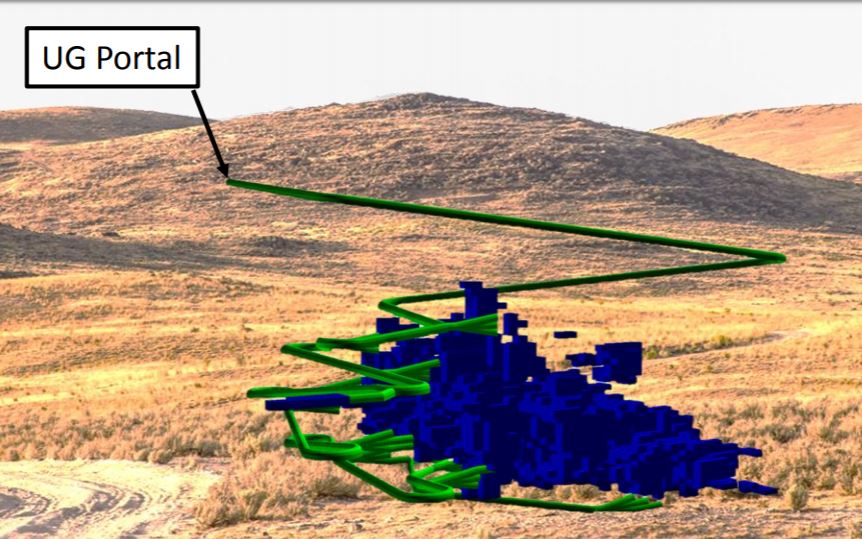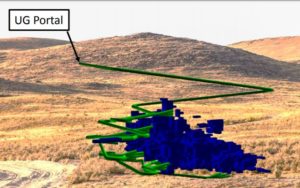Paramount Gold Nevada on track to develop new Oregon mine

3D illustration depicting the envisaged underground mining operation at Paramount Gold's Grassy Mountain Gold Project 22 miles southwest of Vale, Oregon. Source: Paramount Gold Nevada Corp.
By Peter Kennedy

Paramount Gold Nevada Corp. [PZG-NYSE American] will focus on securing vital permits for its 100%-owned Grassy Mountain Gold Project in Oregon after releasing the results of a pre-feasibility study on May 24, 2018.
During a telephone interview with Resource World Magazine on Friday May 25, Paramount President Glen Van Treek said he hopes to secure the permits in time to start production before the end of 2021.
“We hope to have all the permits in place by the end of next year to start building the mine,” he said.
“It is a very high-grade project that will be profitable at a low gold price.” Initially, production is expected to come from an underground mine that could be expanded later to include an open pit operation.
Paramount is a spin-out of Coeur Mining Co.’s [CDE-NYSE] $200 million acquisition of Paramount Gold and Silver, which closed in April 2015. With a focus on gold assets in the United States, the company is backed by a shareholder group that includes Seabridge Gold Co. [SEA-TSX] with an 8% interest. Albert Friedberg’s Toronto-based FCMI Financial Corp. is the company’s biggest shareholder with a 20% stake.
The company said the independent NI 43-101 pre-feasibility study (PFS) confirms the robust economics for a proposed underground mining operation at the current gold price. The PFS also provides an updated resource estimate and the project’s first statement of proven and probable reserves.
“The PFS clearly shows that Grassy Mountain is a mine worth building,” said Van Treek. “The results demonstrate a low-cost operation that would deliver exceptional cash-flows over its mine life at the current gold price. The scale and simplicity of the proposed operation is one that we are very confident Paramount can build and manage.”
Van Treek said the PFS also identifies significant opportunities for improving project economics and finding more ore to extend mine life.
He went on to say that the PFS is an important piece in the permit approval process. This process is well advanced and has been marked by a transparent regulatory environment and a receptive, positive response from the Oregon state government.
“Having proved the basic concept of a profitable underground mine at Grassy Mountain, we will now work on optimizing the PFS and expanding our resource base with targeted exploration,” said Van Treek.
Having spent about $3 million so far, Paramount currently has $1.4 million available in its treasury to carry out that plan.
According to the PFS, Grassy Mountain hosts a measured and indicated resource, containing 1.06 million ounces of gold at 0.034 oz/ton (1.17 g/t), plus 3.3 million ounces of silver at 0.107 oz/ton (3.67 g/t).
Proven and probable reserves stand at 362,000 ounces of gold at 0.21 oz/ton (7.20 g/t) plus 516,000 ounces of silver at 0.30 oz/ton (10.3 g/t).
That material is sufficient to support annual production of 47,000 ounces of gold and 50,000 ounces of silver for 7.25 years.
Other highlights of the PFS are as follows:
Cash operating costs estimated at US$528/oz, with total costs projected at US$853/oz (after silver credits).
Total initial capital costs of $110 million, including 12.2 million in mine development and pre-production costs, $13.6 million in owners and working capital and $14.2 million in contingencies.
The base case projects an after-tax internal rate of return (IRR) of 28% at US$1,300 per ounce gold, while the estimated net present value (NPV) exceeds $87 million at a 5% discount rate.
Paramount Gold shares eased 1.6% or $0.024 to $1.50 on Friday, leaving a market cap of $35.3 million, based on 23 million shares outstanding. The shares are trading in a 52-week range of $1.80 and $1.16.
“We believe there is a very good chance [Grassy Mountain] will become the first new gold mine in the State [Oregon],” wrote Canaccord Genuity analyst Tony Lesiak in a research report.
“While Oregon does not have a reputation for mining (there are no operating gold mines), the permitting process is well defined, and management has been working with the Oregon Department of Geology and Mineral Industries (DOGAMI) and Bureau of Land Management (BLM),” Lesiak said.
The Canaccord analyst said there are number of reasons why management can be confident in achieving permitting success. They are as follows:
- The potential project environmental impact is low;
- There is no human habitation to disturb;
- There is no protected wildlife or species (non-sensitive area);
- There are no visual disturbances due to the remote locations;
- The footprint is small and will offer no interference with agricultural activities.
Aside from Grassy Mountain, Paramount Gold Nevada owns a 100% interest in the Sleeper Gold Project, a former high-grade open pit gold producer located about 25 miles northwest of Winnemucca, Nevada. The Sleeper Mine was operated by Amax Gold Inc. from 1986 until 1996, producing 1.66 million ounces of gold and 2.3 million ounces of silver.
Sleeper became one of Nevada’s most profitable gold mines with an average cash cost below US$60 an ounce. While the focus remains on Grassy Mountain, Sleeper could emerge as a longer term, and possibly more significant development opportunity, Lesiak said.
